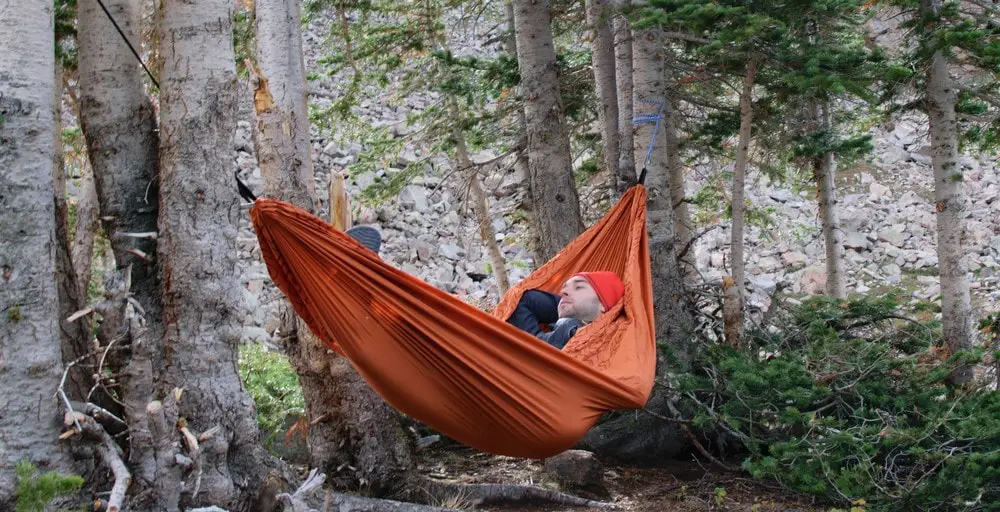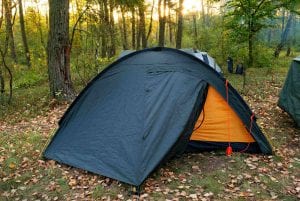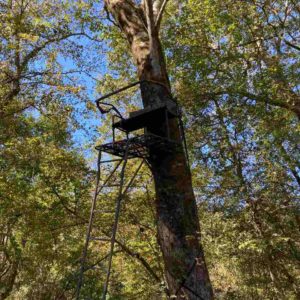
All too often, camping gear gets packed away when the temperatures drop. But after you’ve caught the outdoor bug, the siren call of quiet, uncrowded winter camping can be hard to resist. This leads many aspiring campers to wonder “how cold is too cold for hammock camping?”
As the temps start to get below 65F you definitely want to start thinking about more specialist cold weather gear. Because it all depends on how well you prepare.
But today, we’re here with answers. Keep reading to get the cold weather hammock camping tips that will keep you hanging out comfortably year-round.
Looking for tent camping tips? Check out How to Stay Warm in a Tent.
The Science of Staying Warm
In just a hammock, it can begin to feel cold at night once the temperature dips into the 60°- 65°F range. But campers have enjoyed the comfort and convenience of winter hammocking well below the freezing mark. All it takes is a little science and the right equipment. Below, we’ll introduce the essential pieces of winter hammocking gear from the ground up, including:
- Underquilt
- Sleeping Pad
- Sleeping Bag or blanket
- Rainfly
- And a few extras….
Like staying warm anywhere, staying warm in a hammock is all about your ability to insulate your most important heat source: your body. You do this with layers. But not just the layers you wear. The layers of space and material between your body and the elements are also key. That’s why hammocks offer a distinct advantage over tents when it comes to cold weather camping.
Sleeping on the ground in a tent is a perfect example of conduction. If you think back to science class, that’s when heat or electricity is directly transmitted through a substance where there’s a difference in temperature or electric charge. Like a lightning bolt that reaches out for a tree, when your warm body comes into contact with the cold ground, it loses heat via conduction. This is why a sleeping pad and a sleeping bag are essential for sleeping on the ground. Still, the weight of your body will compress the material and reduce the space available for an insulating air gap.
In a hammock, not only is your body free from the cold grasp of the ground, but it’s easier and more efficient to create an insulated cocoon that keeps you warm all night. That requires layers.
Feathering Your Nest: How to Layer-Up Your Winter Hammock
Start with an Underquilt
Once the temperature drops to 60° and below, a hammock underquilt is almost a necessity. An underquilt isn’t a replacement for a blanket or sleeping bag. Instead, it’s a layer you can easily hang underneath your hammock. This creates a warm pocket of air between the quilt and the hammock that moves with you. It’s better insulated because it can’t be compressed by your weight or rapidly cooled by the ground.
Looking for an underquilt for winter hammocking? Try the Flare. Wise Owl Outfitters designed the Flare to make extra warmth fast and convenient.
Add a Sleeping Pad
Moving up a layer, you can add a sleeping pad either as an alternative to an underquilt or as an additional layer. You can use an inflatable sleeping pad or a closed-cell foam sleeping pad (an insulated inflatable sleeping pad is ideal). For this layer, you’re simply adding an extra barrier between your body and the cold and allowing that barrier to reflect back your body heat.
If you’re already using an underquilt, an extra blanket to sleep on can take the place of a sleeping pad. Remember: while layers equal warmth, the exact equation will differ for everyone. This can require some trial and error! That’s why a daytime test at home or in a local park is always a good idea.
Bundle Up with a Blanket or Sleeping Bag
This tip comes down to personal preference. For many, a sleeping bag that’s been rated for low temperatures adds peace of mind that you’re ready for the cold – at least on paper. That said, many experienced hammock campers will forego a sleeping bag in favor of an insulated camp blanket (or two!). Still, a sleeping bag will also do a great job of insulating your top and sides. You can even find hammock-specific sleeping bags and “mummy” style sleeping bags that are fully enclosed. Experiment with both to discover what’s most comfortable for you.
A recommendation for cooler days:
The Wise Owl Outfitters Toasty Traveler is an insulated blanket that works as a perfect extra layer, whether you’re in a hammock or hanging out trailside. Its handy snap buttons allow you to connect multiple blankets — or wear it like a cloak. It’s perfect for the trail, the beach, and pretty much everywhere in between.
Hang a Tarp
While the lower layers of your winter cocoon protect you from the cold ground, you’ll also want to prevent wind, rain, and snow from leeching your heat. This is where a simple tarp is handy. When hanging your tarp, keep in mind that its job is to trap heat just as much as it is to repel wind and rain. That’s why you’ll want to hang it as low as possible. This creates a floating canopy over your hammock that stays warm and cozy all night.
When combined with a location that’s shielded from the wind and the rain, a tarp quickly puts a lid on your winter hammock set-up to trap and conserve heat to keep you comfortable.
Add an Extra Heat Source
With your body insulated from the ground up and protected from the elements, your next step is to keep as much warmth inside as possible. One way to do that is the old “hot water bottle trick”. It’s simple! Just add boiling water to a water bottle and stash it at your feet. By using conduction to your benefit, the heat from the bottle will travel throughout your body and help keep you warm. Heat packs and hand warmers are also a popular option.
Before You Lie Down, Layer Up
With an insulated shelter accounted for, another important tip for hammock camping in cold weather is to wear more layers. This basic piece of advice is worth repeating because it can quite literally mean the difference between all-night comfort and all-night misery. Besides, any extra clothes you peel off can be used as a pillow.
- Pack an extra-base layer: Having a dry base layer to change into after a long hike or day of activity is a great way to make sure you stay warm all night.
- Wear multiple layers: It’s critical that you stay warm without being too hot. Being able to remove a layer or two to prevent sweating is a smart way to stay comfortable without cooling down.
- Keep layers loose: Just like an underquilt creates an insulating layer of warm air underneath your hammock, loosely fitting layers do the same for your skin. Warm, loose-fitting socks, hats, and gloves should be on everyone’s gear list for winter hammocking.
Get Out and Stay Out
Remember, when you’re hammock camping in cold weather, staying warm and cozy is all about getting your layers right. From the layers underneath and above your hammock to the layers of clothing on your body, every opportunity to create insulation will add to your warmth. With the task of layering complete, you’ll be shocked by how warm winter hammocking camping can be.
So, how cold is too cold for hammock camping? That all depends on how well you prepare. But with just a few basics, we’re confident you’ll be comfortable.





